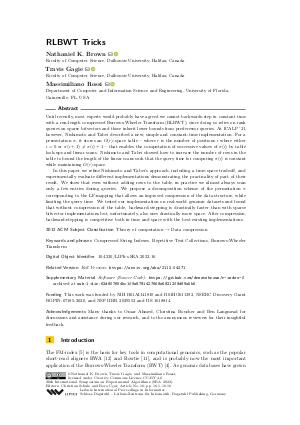RLBWT Tricks
Authors
Nathaniel K. Brown  ,
Travis Gagie
,
Travis Gagie  ,
Massimiliano Rossi
,
Massimiliano Rossi 
-
Part of:
Volume:
20th International Symposium on Experimental Algorithms (SEA 2022)
Part of: Series: Leibniz International Proceedings in Informatics (LIPIcs)
Part of: Conference: International Symposium on Experimental Algorithms (SEA) - License:
 Creative Commons Attribution 4.0 International license
Creative Commons Attribution 4.0 International license
- Publication Date: 2022-07-11
File

PDF
LIPIcs.SEA.2022.16.pdf
- Filesize: 1.27 MB
- 16 pages
Document Identifiers
Related Versions
- Full Version https://arxiv.org/abs/2112.04271
Subject Classification
ACM Subject Classification
- Theory of computation → Data compression
Keywords
- Compressed String Indexes
- Repetitive Text Collections
- Burrows-Wheeler Transform
Metrics
- Access Statistics
-
Total Accesses (updated on a weekly basis)
0Document
0Metadata
Abstract
Until recently, most experts would probably have agreed we cannot backwards-step in constant time with a run-length compressed Burrows-Wheeler Transform (RLBWT), since doing so relies on rank queries on sparse bitvectors and those inherit lower bounds from predecessor queries. At ICALP '21, however, Nishimoto and Tabei described a new, simple and constant-time implementation. For a permutation π, it stores an O (r)-space table - where r is the number of positions i where either i = 0 or π (i + 1) ≠ π (i) + 1 - that enables the computation of successive values of π(i) by table look-ups and linear scans. Nishimoto and Tabei showed how to increase the number of rows in the table to bound the length of the linear scans such that the query time for computing π(i) is constant while maintaining O (r)-space. In this paper we refine Nishimoto and Tabei’s approach, including a time-space tradeoff, and experimentally evaluate different implementations demonstrating the practicality of part of their result. We show that even without adding rows to the table, in practice we almost always scan only a few entries during queries. We propose a decomposition scheme of the permutation π corresponding to the LF-mapping that allows an improved compression of the data structure, while limiting the query time. We tested our implementation on real-world genomic datasets and found that without compression of the table, backward-stepping is drastically faster than with sparse bitvector implementations but, unfortunately, also uses drastically more space. After compression, backward-stepping is competitive both in time and space with the best existing implementations.
Cite As Get BibTex
Nathaniel K. Brown, Travis Gagie, and Massimiliano Rossi. RLBWT Tricks. In 20th International Symposium on Experimental Algorithms (SEA 2022). Leibniz International Proceedings in Informatics (LIPIcs), Volume 233, pp. 16:1-16:16, Schloss Dagstuhl – Leibniz-Zentrum für Informatik (2022)
https://doi.org/10.4230/LIPIcs.SEA.2022.16
BibTex
@InProceedings{brown_et_al:LIPIcs.SEA.2022.16,
author = {Brown, Nathaniel K. and Gagie, Travis and Rossi, Massimiliano},
title = {{RLBWT Tricks}},
booktitle = {20th International Symposium on Experimental Algorithms (SEA 2022)},
pages = {16:1--16:16},
series = {Leibniz International Proceedings in Informatics (LIPIcs)},
ISBN = {978-3-95977-251-8},
ISSN = {1868-8969},
year = {2022},
volume = {233},
editor = {Schulz, Christian and U\c{c}ar, Bora},
publisher = {Schloss Dagstuhl -- Leibniz-Zentrum f{\"u}r Informatik},
address = {Dagstuhl, Germany},
URL = {https://drops.dagstuhl.de/entities/document/10.4230/LIPIcs.SEA.2022.16},
URN = {urn:nbn:de:0030-drops-165500},
doi = {10.4230/LIPIcs.SEA.2022.16},
annote = {Keywords: Compressed String Indexes, Repetitive Text Collections, Burrows-Wheeler Transform}
}
Author Details
Funding
This work was funded by NIH R01AI141810 and R01HG011392, NSERC Discovery Grant RGPIN-07185-2020, and NSF IIBR 2029552 and IIS 1618814.
Acknowledgements
Many thanks to Omar Ahmed, Christina Boucher and Ben Langmead for discussions and assistance during our research, and to the anonymous reviewers for their insightful feedback.
Supplementary Materials
-
Software (Source Code)
https://github.com/drnatebrown/r-index-f
browse
 archived version
archived version
References
-
Omar Ahmed, Massimiliano Rossi, Sam Kovaka, Michael C. Schatz, Travis Gagie, Christina Boucher, and Ben Langmead. Pan-genomic matching statistics for targeted nanopore sequencing. iScience, 24(6):102696, 2021.

-
Hideo Bannai, Travis Gagie, and Tomohiro I. Refining the r-index. Theor. Comput. Sci., 812:96-108, 2020.

-
Christina Boucher, Travis Gagie, Alan Kuhnle, Ben Langmead, Giovanni Manzini, and Taher Mun. Prefix-free parsing for building big BWTs. Algorithms Mol. Biol., 14(1):13:1-13:15, 2019.

-
Michael Burrows and David J. Wheeler. A block-sorting lossless data compression algorithm. Technical Report 124, DEC, 1994.

-
Paolo Ferragina and Giovanni Manzini. Indexing compressed text. J. ACM, 52(4):552-581, 2005.

-
Travis Gagie, Gonzalo Navarro, and Nicola Prezza. Fully functional suffix trees and optimal text searching in BWT-runs bounded space. J. ACM, 67(1):2:1-2:54, 2020.

-
Simon Gog, Timo Beller, Alistair Moffat, and Matthias Petri. From theory to practice: Plug and play with succinct data structures. In 13th International Symposium on Experimental Algorithms (SEA), pages 326-337, 2014.

-
Simon Gog, Juha Kärkkäinen, Dominik Kempa, Matthias Petri, and Simon J. Puglisi. Fixed block compression boosting in FM-indexes: Theory and practice. Algorithmica, 81(4):1370-1391, 2019.

-
Peter W Harrison et al. The COVID-19 Data Portal: accelerating SARS-CoV-2 and COVID-19 research through rapid open access data sharing. Nucleic Acids Research, 49(W1):W619-W623, 2021.

-
Alan Kuhnle, Taher Mun, Christina Boucher, Travis Gagie, Ben Langmead, and Giovanni Manzini. Efficient construction of a complete index for pan-genomics read alignment. J. Comput. Biol., 27(4):500-513, 2020.

-
Ben Langmead, Cole Trapnell, Mihai Pop, and Steven L Salzberg. Ultrafast and memory-efficient alignment of short DNA sequences to the human genome. Genome biology, 10(3):1-10, 2009.

-
Heng Li and Richard Durbin. Fast and accurate short read alignment with Burrows-Wheeler transform. Bioinform., 25(14):1754-1760, 2009.

-
Veli Mäkinen, Gonzalo Navarro, Jouni Sirén, and Niko Välimäki. Storage and retrieval of highly repetitive sequence collections. J. Comput. Biol., 17(3):281-308, 2010.

-
Gonzalo Navarro. Compact Data Structures - A Practical Approach. Cambridge University Press, 2016.

-
Takaaki Nishimoto and Yasuo Tabei. Optimal-time queries on bwt-runs compressed indexes. In 48th International Colloquium on Automata, Languages, and Programming (ICALP), pages 101:1-101:15, 2021.

-
Massimiliano Rossi, Marco Oliva, Ben Langmead, Travis Gagie, and Christina Boucher. Moni: A pangenomic index for finding maximal exact matches. J. Comput. Biol., 29(2):169-187, 2022.

-
The 1000 Genomes Project Consortium. A global reference for human genetic variation. Nature, 526(7571):68-74, 2015.

